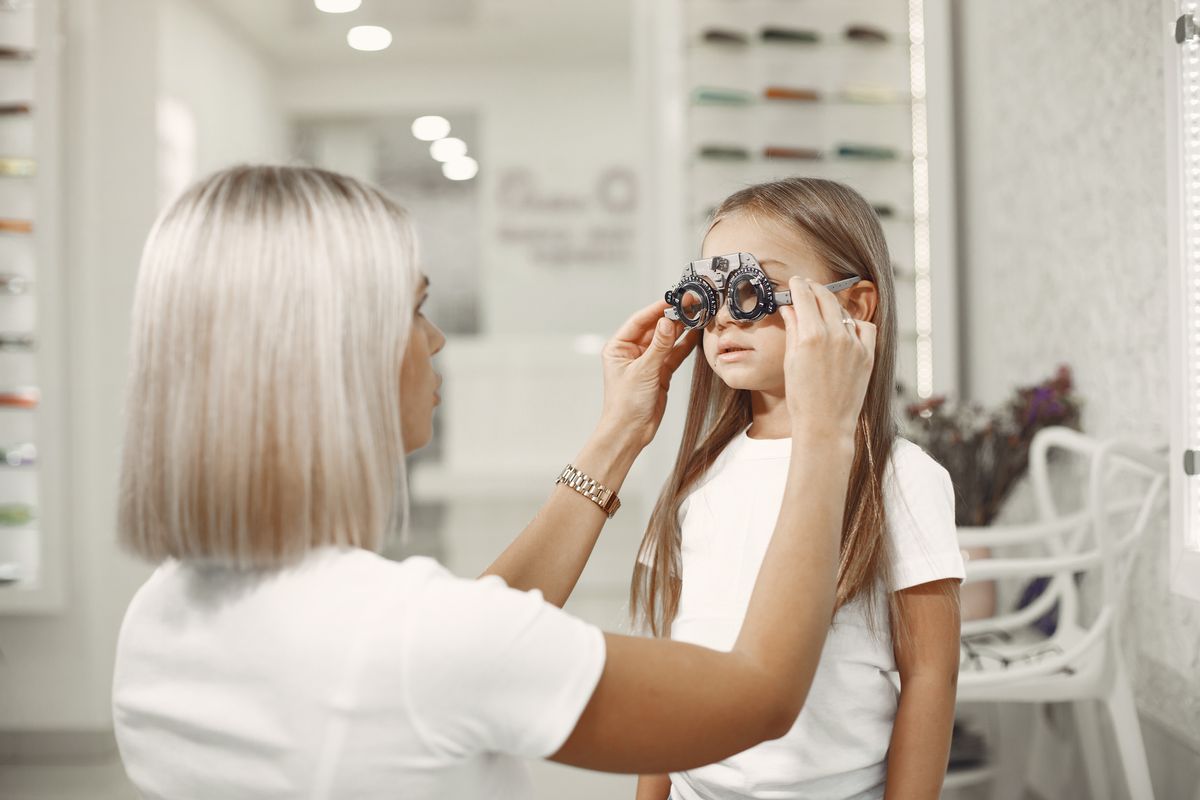
Last Updated on July 14, 2025 by Dr. Azhar I. Salahuddin
What is Astigmatism in Children?
Astigmatism is the imperfection of the cornea’s curvature or lens. The cornea is the transparent layer on the outside of the eye that transmits and focuses the entry of the light into the eye.
A healthy cornea will properly refract the light, but children with astigmatism will have an egg-shaped cornea. Because of this, there is no proper refraction of light rays, causing blurry vision.
What Causes Astigmatism In Children and Infants?
Here are several factors that contribute to the development of astigmatism in children and infants.
-
Family History
If astigmatism runs in your family history, your child is more likely to get affected by it.
-
Refractive Error
If your child is already suffering from other common refractive errors such as myopia (nearsightedness) and hyperopia (farsightedness), their chances of developing astigmatism increase.
-
Maternal Smoking
Few studies have shown that kids whose mothers smoked during pregnancy developed astigmatism.
-
Certain Heritage
According to previous studies on preschool children, a particular pattern showed that kids with African-American, Asian, and Hispanic heritage were at a higher risk of developing astigmatism than children from other heritages.
Signs of Astigmatism in Kids
It is difficult to detect symptoms of astigmatism in children because they typically can not vocalize their vision problems. But fortunately, there are several series of screenings that your child can go through at the eye doctor to detect the signs.
While in between the visits, it is important to keep an eye out for the following signs of astigmatism in children.
-
Light Sensitivity
People with astigmatism find lights to appear streaky or smeared with high glare, making it hard to focus on them. If your child seems sensitive to lights, he has probably developed astigmatism.
-
Squinting
Sometimes kids use their own vision correction methods, such as squinting their eyes or constantly closing eyes, and tilting their heads, to focus on something. If you notice your child doing this while watching television, reading, or even just looking at something from a distance, consult an ophthalmologist.
-
Eye Rubbing
Eye rubbing is a sign of tired eyes, and if you see your child rubbing their eyes, this indicates eyestrain. Encourage your child not to rub their eyes as this causes damage to the eye and its surrounding tissues.
-
Too Close to Digital Screens or Books
Bringing a digital device or books right near one’s face is a sign of underlying vision problems. The light coming from devices or print books could appear blurry to a child with astigmatism, forcing them to move closer to the object.
Do Children Grow Out of Astigmatism?
According to statistics, 23% of infants from the age of 6 to 12 months have astigmatism, but as they grow, their eyes develop, correcting this refractive error and further dropping the statistics to 9% by the age of 5 to 6.
It is common for astigmatism in children to resolve on its own, but you should not solely rely on this. You need to keep track of your child’s visual behaviors and save their eyesight, as severe astigmatism in children leads to amblyopia (lazy eye), which can threaten their vision.
Now, just as it is possible for your child to grow out of astigmatism, it is also possible that they won’t. If your child does not grow out of astigmatism, several other treatments are available.
Astigmatism Treatment Options for Kids
Here are a few astigmatism treatment options you can discuss with your child’s ophthalmologist to get your child’s astigmatism treated.
-
Natural Treatment
Various natural treatments can be done within the comfort of your home. Following a healthy diet is one of them, as it provides your child with all the nutrients such as:
Vitamin A
Vitamin A-enriched foods such as eggs, milk, green leafy vegetables, fruits, and beef liver help protect the eyes’ exterior surface.Vitamin C
Vitamin C-rich foods are recognized as the building block for strong capillaries that maintain the blood flow to the eyes. Cantaloupe, strawberries, kale, and oranges contain vitamin C.Vitamin D
Vitamin D is essential for the overall health of your eyes, and you can find it in the sun, fortified milk and cereals, fatty fish like salmon or tuna, mushrooms, and pork.Also Read How to Fix Astigmatism Naturally?
-
Eyeglasses
Eyeglasses are the most common tool for correcting astigmatism. Regular visits to your child’s eye doctor, typically once a year, are important to ensure their glasses are properly adjusted for effective correction.
However, if your child complains about not seeing with their current glasses, don’t wait for yearly appointments; make one right away.
-
Contact Lenses
Contact lenses used for correcting astigmatism are known as toric lenses. They are recommended for low-grade astigmatism. Other options include gas permeable and hybrid contact lenses.
-
Refractive Eye Surgery
Refractive surgery is a type of surgery that corrects the shape of the eye.
Tips Parents Should Follow
Apart from the above treatments, these are some additional tips you can follow to protect your child’s eyes.
- Encourage your child to wear their prescribed glasses.
- Regular eye check-ups are crucial.
- Restrict their screen-time.
- Add outdoor playtime into their routine.
- Keep your infants away from sharp toys.
- Make them try a few eye exercises daily.
Read more on detailed eye health tips – 6 Essential Eye Health Tips for Protecting Your Child’s Vision
Consult an Ophthalmologist
If you live in Fresno, CA, and notice your child facing vision problems, visit eye doctors at InSight Vision Center now and get them treated to avoid any severities.
If you’ve noticed signs of astigmatism or other vision problems in your child, early intervention is key to protecting their eyesight. Book an appointment with our experienced ophthalmologists at InSight Vision Center in Fresno, CA, today. Request an Appointment

Dr. Azhar I. Salahuddin is an ophthalmologist and is fellowship-trained in cornea, external diseases, and refractive surgery. Dr. Salahuddin has been performing cataract surgery for over 19 years and specializes ocular reconstruction, corneal transplantation surgery as well as vision correction through a variety of intraocular lenses. Dr. Salahuddin is board-certified by the American Board of Ophthalmology and was trained at Boston University.

